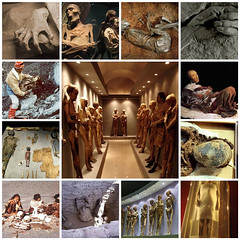
A recent find has archaeologists and pet-lovers equally excited. How much do you love your little Fido? Enough to wrap him in linen and take him with you? I'm not thinking summer vacation here but something more along the lines of Valhalla. That is exactly what happened to an Egyptian puppy some 2,300 years ago.
As an Egyptian tomb was excavated recently, an "awe" arose due to its cuddly find. Hapi-Puppy, a 2,300 year old mummified pet met his end when his owner "Hapi-Men" passed away. Many Egyptian tombs contain cats, birds and baboons to accompany their masters into the afterlife. This happy fellow wanted his pet dog.
2,300 years too late, animal activisits are asking questions about the ritual that would have taken a perfectly healthy puppy and put him in the tomb. Timing is everything and nature tends not to have the whole household pass away at once, so yes, a little coaxing was necessary. The practise, however, was common for more than pets. Wives, slaves, pets and all of life's luxuries were packed up and tucked in with the mummified loved one when they passed.
Playing on the outrage button so easily pressed in our society, Samuel Langhorne Clemens, better known as Mark Twain, popularized the urban myth that mummies were used as fuel for locomotives. Had this been the case for our dear mummified Happi-Puppy, it would certainly have made him a hot dog. Given their value to museums, it is highly unlikely that this would have ever been a regular practise, though thousands of cat mummies were shipped to the United Kingdom to be used as fertilizer. I think Hapi-Puppy would have chosen to stay with his master over perking up an English rose garden.
Recent Cat Scans from Penn State Museum show that their little cat was really a puppy, too: http://www.youtube.com/watch?v=oUaJsHLqMQU
For those of you interested to know more about Fermilab mummifying Buffalo to help them glow in the dark, visit:
http://www.science20.com/kuday/blog/buffalos_glow_fermilab





Comments